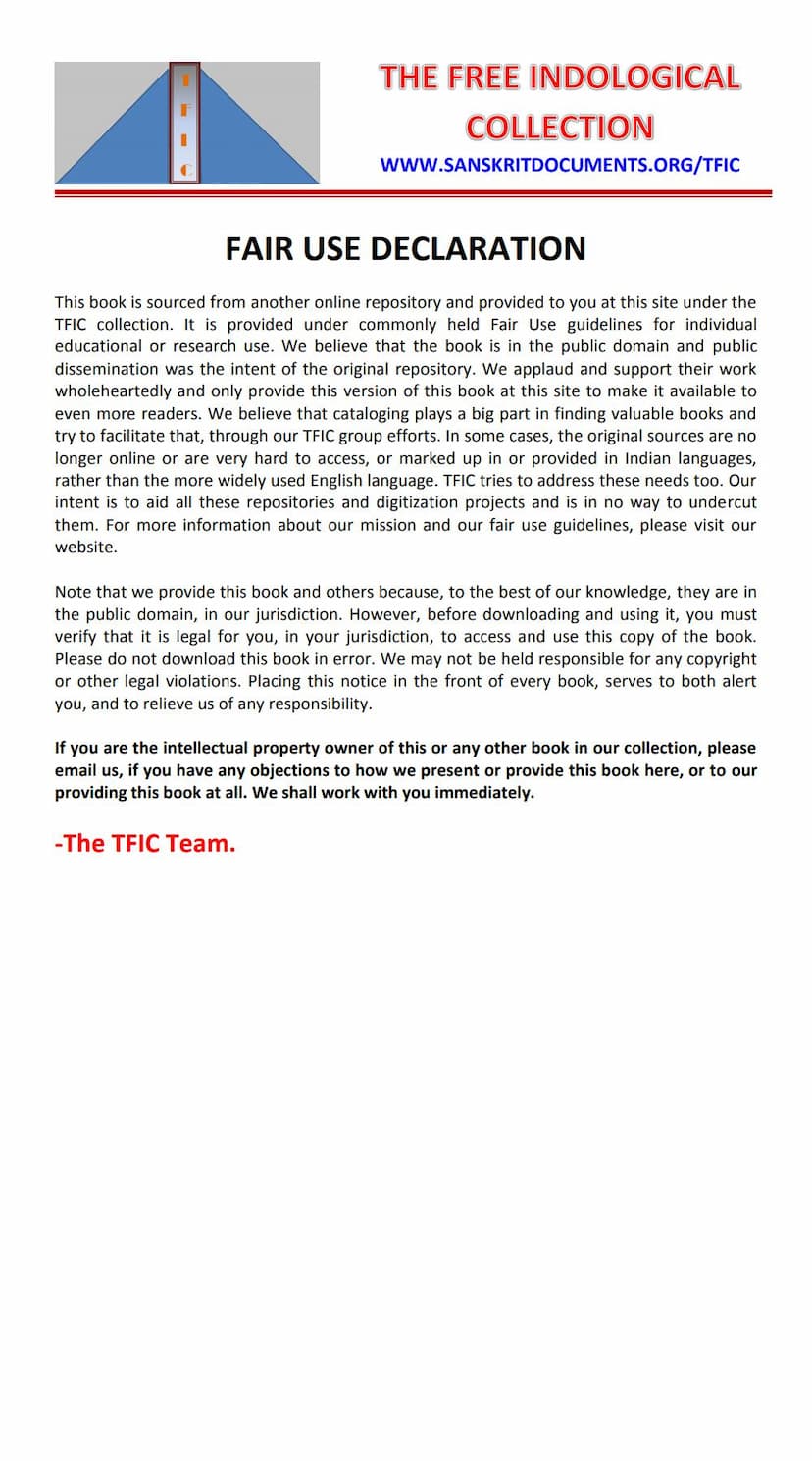Jain Gita
Added to library: September 2, 2025

Summary
This is a comprehensive summary of the Jain text "Jain Gita" by Acharya Vidyasagar, published by Ratanchand Bhayji Damoha, based on the provided pages.
Book Title: Jain Gita Author: Acharya Vidyasagar Publisher: Ratanchand Bhayji Damoha Catalog Link: https://jainqq.org/explore/010235/1
Overall Purpose and Context:
"Jain Gita" is presented as a Hindi poetic translation of the "Shramana Suttam" (also known as "Shraman Sutra" or "Shraman Suttam" in Ardhamagadhi). The book's creation was inspired by a desire to present the essence of Jainism in a way that is accessible to everyone, including those outside the Jain faith, and to provide a universally accepted summary of Jain teachings, akin to the Bhagavad Gita for Hinduism or the Dhammapada for Buddhism.
Key Contributors and Inspiration:
- Acharya Vidyasagar: The author and translator, revered for his scholarship, spiritual depth, and ascetic practices. He undertook the monumental task of translating the "Shramana Suttam" into poetry in Hindi.
- Vinoba Bhave: A prominent social reformer and follower of Mahatma Gandhi, Vinoba Bhave is acknowledged as the inspiration behind the project. He had long advocated for a Jain text that would encapsulate the core principles of Jainism for mass consumption. He is quoted on page 8 expressing his satisfaction with the realization of this vision.
- Jineshwardas Varni (Jineandra Varni): Credited with compiling the "Shramana Suttam" (Sammana Suttam), a collection of universally accepted Jain principles from various canons, which served as the original source for Acharya Vidyasagar's translation.
- Pandit Kalashchandra Ji Siddhantacharya: Provided a prose translation of the "Shramana Suttam," which aided Acharya Vidyasagar in understanding the nuances of the original Prakrit verses.
- Pandit Jamnalal Ji Shastri and Shri Krishnagaj Mehta Ji: Their letters from Banaras served as a further impetus for Acharya Vidyasagar to undertake the poetic translation.
- Acharya Gyan Sagar Maharaj Ji: Acharya Vidyasagar's spiritual guru, under whose inspiration and blessings this work was completed. Acharya Gyan Sagar himself abdicated his Acharya-ship to Vidyasagar.
- Singhai Gulabchand, Damoh: The editor and a devotee who expresses deep reverence for Acharya Vidyasagar and his associates, detailing their spiritual journey and contributions.
Content and Structure:
The "Jain Gita" is structured into four sections, further divided into chapters (Sutras), each focusing on specific Jain philosophical and ethical concepts. The translation aims to be poetic and easily understandable, using verses that can be sung and remembered.
- First Section: Jyotirmukh (Light-Faced)
- Covers foundational concepts like auspicious verses (Mangal Sutra), the Jain scripture (Jin Shasan Sutra), the monastic community (Sangh Sutra), the nature of reality (Nirupan Sutra), the cycle of existence (Sansar Chakra Sutra), karma (Karma Sutra), delusion (Mithyatva Sutra), renunciation of passion (Rag Parihar Sutra), duty (Dharma Sutra), self-control (Sanyam Sutra), non-possession (Aparigraha Sutra), non-violence (Ahimsa Sutra), diligence (Aprasad Sutra), teachings (Shiksha Sutra), and the soul (Atma Sutra).
- Second Section: Moksha Marg (Path to Liberation)
- Details the path to liberation, including the path itself (Moksha Marg Sutra), the three jewels (Ratnatray Sutra), right faith (Samyakdarshan Sutra), right knowledge (Samyakgyan Sutra), right conduct (Samyakcharitra Sutra), spiritual practice (Sadhana Sutra), dual nature of duty (Dwividha Dharma Sutra), duties of lay followers (Shravak Dharma Sutra), duties of monks (Shraman Dharma Sutra), vows (Vrat Sutra), discipline and restraint (Samiti Gupta Sutra), daily duties (Avashyak Sutra), asceticism (Tap Sutra), meditation (Dhyan Sutra), contemplation (Anupeksha Sutra), spiritual states (Leshya Sutra), and self-development (Atma Vikas Sutra). It also includes a sutra on sallekhana (Sallekhana Sutra).
- Third Section: Tattva Darshan (Glimpse of Principles)
- Focuses on the core principles, with sutras on principles (Tattva Sutra), substances (Dravya Sutra), and creation (Srishti Sutra).
- Fourth Section: Syadvada (The Doctrine of Conditional Existence)
- Explores the Jain theory of manifold perspectives, including non-absolutism (Anekant Sutra), proofs (Praman Sutra), categories of reasoning (Nay Sutra), the seven-fold conditional statement (Syadvada Saptamthi Sutra), coordination (Samanvay Sutra), classification (Nikshep Sutra), and concluding remarks (Samapan Sutra), ending with praise for Lord Mahavir (Veer Stavan).
Key Jain Concepts Explained:
The book delves into various fundamental Jain principles, including:
- Ahimsa (Non-violence): Emphasized as the paramount principle, extending to all living beings.
- Aparigraha (Non-possession): The importance of detachment from material possessions.
- Tapas (Austerities): The role of various forms of penance in spiritual purification.
- Ratnatraya (Three Jewels): Right Faith, Right Knowledge, and Right Conduct as the path to liberation.
- Anekanta/Syadvada: The principle of manifold perspectives, acknowledging that truth can be viewed from different angles.
- Karma: The intricate law of karma and its impact on rebirth.
- Sallekhana: The pious fasting unto death, a practice of spiritual preparation.
- Samitis and Guptis: The five restraints and three controls that guide monastic conduct.
- Shravak Dharma: The duties and vows of Jain lay followers.
The Translation Style:
The translation is praised for its poetic quality, making profound philosophical concepts accessible. Acharya Vidyasagar's mastery of Hindi and Sanskrit is highlighted, with his ability to convey deep spiritual insights in verses that are both melodious and meaningful. The verses are designed to be easily remembered and sung, facilitating wider dissemination and understanding.
Praise and Dedication:
The book is filled with expressions of reverence and admiration for Acharya Vidyasagar and his spiritual lineage. The introductory sections include tributes from Vinoba Bhave and Singhai Gulabchand, underscoring the significance and impact of this work within the Jain tradition and beyond. The book is dedicated to Acharya Gyan Sagar Maharaj Ji.
Conclusion:
"Jain Gita" is a significant work that aims to distill the vast and profound teachings of Jainism into an accessible and inspiring poetic format. It serves as a guide for spiritual seekers, offering a path towards liberation through adherence to Jain principles and practices, as envisioned and beautifully rendered by the erudite Acharya Vidyasagar.